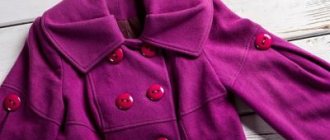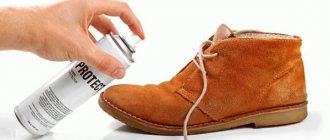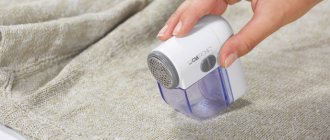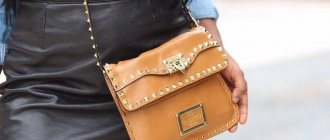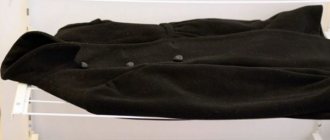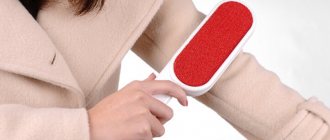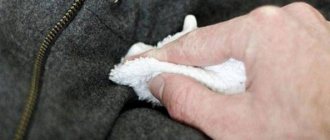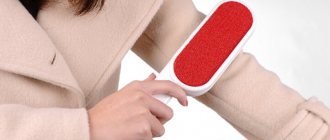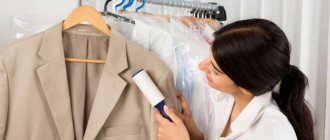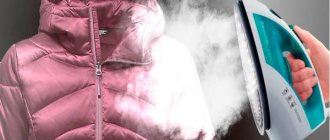I bought a suede jacket at the market, but, unfortunately, it turned out to be wrinkled. Is there any way to pet her?
Suede is a type of leather made from animal skins with a loosened outer layer. To obtain a velvety surface, it is greased and then repeatedly processed in impact pulverizers. The material acquires a characteristic yellowish-brown color and becomes soft to the touch.
It is sometimes difficult to distinguish leather from artificial suede. When you pass your hand over the surface, the fibers of natural material change their inclination, while artificial fibers restore their original appearance. Suede does not smell like chemicals, but like leather. It absorbs water instantly, leaving a wet spot where it gets wet. Drops remain on the artificial material.
Items made from artificial suede can be ironed, but not in all cases. Before you dare to experiment, you need to carefully study the product tag.
Like any type of leather, natural suede should not be ironed, as well as dry cleaned or washed. During processing at elevated temperatures or soaking, it loses its appearance and becomes deformed. Some housewives try to iron it through the fabric on the “unit”. However, it is impossible to completely get rid of creases using this method, and it is possible to spoil the thing.
To smooth a leather product, use a steam generator. You can also hang it on hangers, having previously steamed it over a container of hot water. After 2 days, the creases will be removed and the item will look ironed.
Modern artificial suede is a material whose appearance is not much different from natural suede. It has the same qualities: velvety, plasticity and wear resistance. The main advantage of products made from artificial suede is that they are much cheaper. But caring for them is not much different from caring for natural materials and requires a delicate approach. This applies to both cleaning and ironing.
In order not to spoil your favorite item or damage the surface, you need to know a few rules on how to iron faux suede.
Some people are afraid to purchase clothes made from faux suede or take things to the dry cleaner because they don’t know how to iron faux suede. In reality it's not that difficult. It is important that the iron has a steaming function, then the smoothing process will be fast and - most importantly - safe for the product. Under no circumstances should you set the iron to the maximum temperature; it should be medium. Before you start ironing, do a small “test” on an inconspicuous place on the lining side.
As is the case with natural material, artificial suede products can only be ironed from the wrong side through the lining. It is advisable to use silk lining fabric or purchase a special lining, which will also help in smoothing out other “capricious” materials.
If creases appear on items made of artificial suede after washing, cleaning or wearing for a long time, they can be pre-steamed by holding them over a boiling kettle or pan. In the same way, you can smooth out a small item by hanging it on a hanger over steam, and then gently wipe it with a dry cloth. It is possible that this will be enough and additional ironing of the product will not be necessary.
Rules for washing eco-suede items
Delicate material does not tolerate prolonged contact with water, but washes well. Small stains should be removed immediately after they are discovered, avoiding deep penetration of dirt into the pile. In addition, it is necessary to carry out general cleaning of products in a timely manner and monitor the condition of the material.
It is important not to forget that:
suede does not tolerate soaking, contact with hot water, drying near heating devices,- the material is deformed from squeezing, twisting, tightly folding,
- as a result of the wrong choice of household chemicals, stains appear on the fabric,
- For washing, you can use professional or liquid gel products.
Bleach, caustic stain removers, rinse conditioner, and regular cheap powder are prohibited.
Manual cleaning
Gentle cleaning will help restore freshness to suede items, remove minor dirt, scuffs, and stains.
- Pour a sufficient amount of warm water into a large basin or bathtub.
- Dilute the detergent. There should be no undissolved granules.
- Carefully immerse the item in the water. If there is heavy contamination, the soaking time should not exceed 10–15 minutes.
- Treat the product with a soft rubberized brush or sponge, paying special attention to problem areas (collar, cuffs, pockets, armpits). You need to act in one direction so as not to damage the pile. Do not rub, squeeze or crumple the fabric!
- Rinse, changing the water several times. During the last rinse, add 3-4 tbsp to the basin. l. vinegar. It will help restore softness.
- Place clothes over the bath and let the water drain. Don't squeeze! It is permissible to blot the product with a towel to remove excess moisture.
Machine processing
Automatic processing of eco-suede clothing is undesirable . From rough impact, the material will quickly become unusable, the pile will lose its uniformity, and streaks will appear.
You can clean suede items in a washing machine, provided there is an appropriate mark on the product label. Before processing, clothes must be shaken, turned inside out, pockets checked, and any loose seams sewn up.
Then you need:
Set the gentle mode (“hand wash”, “wool”, “silk”, “for delicate fabrics”).- Choose a liquid detergent (Ariel, Tide, Persil, Laska gels, capsules, fragrance-free baby shampoo).
- Set water heating to 30 degrees.
- Remove the spin and dry modes.
- Carefully place the clothes into the drum of the machine and start the cycle.
- Place the item on the bottom of the bathtub or place it above the basin and allow the water to drain.
- Dry outdoors.
How to deal with creases on suede
Creases always remain, and, unfortunately, it will not be possible to get rid of them completely. And is there any point in this if the shoes continue to be worn? But making them less noticeable is possible. To do this, use both improvised means that can be found in everyone’s home, and special ones that can be purchased at shoe stores.
Handy tools to help
The easiest and most effective way is to use steam. It does not require large financial expenditures, but it will require a significant amount of time. This method is as follows.
- Wash the product clean.
- Boil water in a wide container.
- Hold the shoe over the water so that the steam hits the defect.
Important! Be careful not to get burned.
It is also important to remember that moisture can ruin this material, so you should keep your shoes over steam for a short period of time. When you notice that the surface is starting to get a little wet, remove the shoe . Next, blot it with a dry cloth and leave to dry. At this time, carry out the procedure with the other shoe.
If the creases are still very visible the first time, repeat the procedure.
The procedure with steam can also be performed using an iron. To do this, follow the instructions:
- Push papers into the shoes to give them shape (you can use old newspapers).
- Cover the boots with a thin cloth.
- Turn on the most powerful steam setting and hold the iron over your boots.
On a note! Be careful not to touch the boot with the soleplate of the iron.
The iron can be replaced with a steamer.
Coffee grounds will help deal with the brown product.
- Take the coffee grounds.
- Rub the boot with it in the crease area.
- Leave it for a while and shake off the dried grounds.
Important! This method is only suitable for dark brown suede. Using it on a light color can result in an unsightly stain.
Professional care
Professional products include paint, which can be purchased at a shoe store.
A suede pair often comes with a can of spray paint. Using the spray is quite simple. You need to wash your shoes well and let them dry. Then spray the spray and spread evenly over the surface with a brush.
The paint will help hide the creases. But steam is better for removing them.
Drying and ironing
Proper care of faux suede clothing includes mandatory adherence to recommendations for drying and ironing products:
After washing, the material must not be twisted. Things should be placed above the basin or placed on the bottom of the bathtub, and the water should be allowed to drain freely.- Excess moisture can be blotted with a towel. Another option: lay the clothes horizontally on a terry sheet, roll them, and gently wring them out.
- It is better to dry suede in a horizontal position in the fresh air or in a well-ventilated area. In a closed bathroom, the material will not dry out and will acquire a musty smell.
- Wet clothes should be protected from direct sunlight and radiators, and should not be taken out onto the balcony during frost.
- To maintain their shape, hats, gloves, bags, and shoes must be filled with crumpled paper or newspapers during drying, changing them as moisture is absorbed.
- Faux suede can only be ironed from the reverse side with a warm iron. To protect the material, it is worth placing a special ironing net or thin cloth.
If there are deep creases or folds, it is better to steam the clothes. After treatment, you need to walk over the entire surface with a dry brush to remove moisture and lift the pile.
Basics of care
Genuine leather has features that should be taken into account when purchasing and wearing shoes. To prevent creases from forming on shoes and boots, you need to follow simple rules:
- You must always keep shoes made from natural materials clean and use them only for their intended purpose.
- Wet shoes need to be dried at room temperature. To prevent the product from deforming, you should stuff it tightly with paper.
- After drying, the skin must be treated with a special cream or wax to soften and moisturize it.
- You should not wear wet shoes, as the leather will stretch in this state.
- It is necessary to select a pair that matches your foot size.
- You can store boots, boots and shoes in cardboard boxes or textile bags, but not in plastic bags, which limit the access of oxygen.
Important! It is better not to use silicone-based shoe products, as they do not moisturize them, but only add shine and attract dust. It is not recommended to use heating devices or other heat sources for drying.
Removing stains
To remove minor stains from clothes or shoes made of artificial suede, you can use folk remedies:
- Fat. Fresh drops should be covered with starch, baby powder, and crushed chalk. After 15–30 minutes, brush off the product and carefully wash the damaged area with a cotton pad and soap solution.
- Juice, grass, pollen, any stains of organic origin can be wiped off with a cloth moistened with vinegar (9%).
- Wine. A fresh stain should be blotted with a dry, clean cloth. To remove dried marks, use a thick soap solution or shaving foam. The product should be applied to the stain, left for half an hour, and the residue removed with a napkin.
- Gum. Rub the sticky mass with an ice cube. When the gum hardens, carefully remove it from the fabric.
- Dirt. Do not touch wet drops; you must wait until they dry. Then clean the damaged area with a brush.
- Glue, varnish, traces of cosmetics . Gently rub the marks with a cloth moistened with nail polish remover without acetone.
Why do creases appear on shoes?
To begin with, we suggest understanding the causes of such defects.
When we see a pair in the store, especially the suede one, it looks perfect. And we want it to remain that way. But this is impossible. During walking, the position of the foot changes. The shoes, in turn, follow the movements of the foot, which is why creases appear in the toe area. On a note! More severe creases remain on shoes with flat soles.
If you wear your boots or shoes carefully, natural creases remain almost invisible. But if you treat your shoes incorrectly, do not clean them in a timely manner and store them carelessly, you risk leaving significant defects on them, which will then be difficult to get rid of.
Dry cleaning
Following all the rules and recommendations, you can wash the following at home:
It is better to dry-clean jackets, outerwear, and hats. It is very difficult to remove stains or dirt from them on your own.
There is a high probability of product deformation. In addition, it is almost impossible to properly dry and steam a suede coat at home .
The cost of dry cleaning will start from 500 rubles and can reach 2-3 thousand rubles.
How to remove cracks, scratches and dents from shoes, sneakers or boots
As a result of improper care or its complete absence, not only wrinkles, but also cracks and scratches may appear on the surface of suede, natural or artificial eco-leather. In such cases, you should not be too upset, since the problem has a solution.
What do you need for work?
- “Liquid Skin” product of a suitable color;
- small rubber spatula;
- wax or paraffin (for scratches);
- sandpaper grit P200-P240 - marking according to the new GOST 3647-80 or diamond mesh;
- technical or medical alcohol (white spirit is possible);
- shoe cream of the desired color.
How to get rid of cracks
- Let's figure out how to smooth out folds on leather shoes in which cracks have appeared (they can form between wrinkles or at the top of the crest of the deformation). First you need to find and buy a special restoration product called “Liquid Skin”. But it must match the color of your shoes, otherwise there will be stripes on the surface, which is also a defect.
- Thoroughly wash your boots, boots or shoes from dirt and grease, and dry your shoes at room temperature. You should not keep it near a radiator or open fire - it may warp.
- In the section “How to smooth out (remove) defects” you have already learned how to remove wrinkles from leather shoes, so first you need to smooth out the wrinkles with an iron. Allow time for the surface to cool to room temperature.
- Sand the damaged areas with sandpaper to smooth out the jagged edges (just be careful - if you overdo it, you will make the problem worse). Treat the surface for degreasing with alcohol or white spirit.
- Apply “Liquid Skin” in the right places. To do this, use a rubber spatula and the “scrape” method so that the product fills the recesses, but does not remain on the surface.
- Wait 5-10 minutes and evaluate the result, but if it turns out to be unsatisfactory, repeat everything again, starting with sanding.
- After drying, treat the shoes with a suitable cream and wear them for your pleasure, without remembering the previous problem.
Tip : when you have sandpaper at home, but you don’t know the grit number, you can determine it yourself. Try sanding a small section of a plastic or wooden student ruler. If there are no deep marks left, then everything is in order - the abrasive is suitable for you.
How to get rid of scratches
Such defects can appear from wire, glass, sharp branches, stones, etc. Assess the depth of the damage by running your fingers, and if you don’t feel anything, you can repair it with shoe polish. Otherwise, use this algorithm:
- Just like a crack, clean the scratch with sandpaper and degrease with alcohol or white spirit.
- Warm the wax until it is pliable in your hands. Rub the damaged area and remove excess with a soft cloth.
- If the scratch turns out to be too deep, then treat it in the same way as with a crack - repair it with “Liquid Leather” using a rubber spatula.
- Treat with a cream of a suitable color and continue using the pair.
Adviсe
If there is heavy contamination, faux suede items can be cleaned in any way if you follow simple recommendations:
- Do not ignore the manufacturer's care instructions on the label.
- Choose cleaning products from the professional series marked “For suede” (shampoos, foams).
- Use gel or soft foaming formulations.
- Wash clothes in warm water (heat should not exceed 30–40 degrees).
- Do not twist, rub, or squeeze. Act as carefully as possible, trying not to stretch or deform the material.
- Pay special attention to rinsing.
- Pre-remove stains and clean greasy areas.
- Wash items completely. Washed areas will be noticeable, streaks will appear, and the structure of the material will not be uniform.
- Regularly treat the material with water-repellent impregnations.
How to remove wrinkles from leather shoes in a simple way
When a person likes his shoes or sneakers, even a small crease in them that cannot be straightened out can cause frustration. Sooner or later everyone has to deal with this. Let's look at one way to remove wrinkles and creases.
Important : to iron leatherette, which is essentially the same leatherette, the cotton mode may be too hot. It’s better to turn down the power a little with the thermostat wheel.
What is needed for this
- iron with steam function;
- small towels;
- ironing board or table;
- backing fabric;
- water.
Instructions
- Make thick rollers out of paper and cardboard and secure them with tape. They should follow the shape of the sole as much as possible - this way you can achieve the greatest effect.
- Insert the inserts into the shoes so that they fit tightly into the space under the area where wrinkles accumulate. You can smooth out sneakers or boots using the same method: the main thing is that the shoes retain their shape as much as possible in the area of the foot and the curve of the head.
- Place the pair to be restored on a table or ironing board, having previously covered the backing, and cover the head with a towel (it should only be made of natural fabric).
- Plug in the iron, setting the thermostat to o or to the position that you use for such fabric. When the sole is warm, begin stroking the surface of the head as you would a wrinkled shirt or trousers - without much effort. You can straighten the material only if the “steam” function is turned on, but your electrical appliance may not have it. In such a situation, there is a simple way out - generously sprinkle a towel, through which you will begin to straighten wrinkles.
- When you finish the procedure, do not rush to pull out the earbuds and remove the protective material. Wait until the shoes cool down completely so that you don’t feel any heat under your palm—this is a necessary condition.
- Treat the surface with shoe polish and you will be able to enjoy the results of your labor for a long time.
